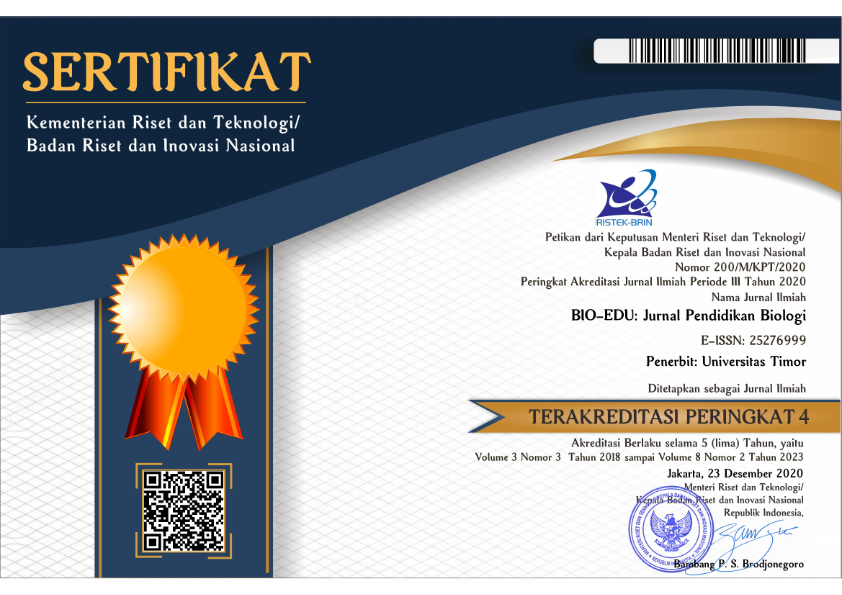Pengembangan Video Pembelajaran Berbasis STEM tentang Bakteri Escherichia coli
DOI:
https://doi.org/10.32938/jbe.v6i3.1186Keywords:
Video pembelajaran; STEM; bakteri Escherichia coliAbstract
Abstrak
Tujuan penelitian ini adalah untuk mengetahui desain dan kelayakan video pembelajaran berbasis STEM dengan topik identifikasi bakteri Escherichia coli pada air sumur. Jenis penelitian ini adalah penelitian pengembangan (research & development) dengan model pengembangan 4D. namun penelitian ini fokus pada 3 tahap yaitu define, design, dan development. Subjek penelitian pada mahasiswa Program Studi Pendidikan Biologi semester 6 dengan jumlah 7-10 mahasiswa sebagai responden. Uji validasi menggunakan 3 validator yang melakukan validasi terkait materi dan media. Instrument pengumpulan data menggunakan angket validasi dan angket respon mahasiswa. Hasil data yang diperoleh menunjukkan bahwa produk video pembelajaran berbasis STEM terkait bakteri Escherichia coli pada air sumur pada kategori “Layak” dengan persentase unsur materi sebesar 72% dan unsur media sebesar 78%. Untuk respon mahasiswa menunjukkan keantusiasan mahasiswa menggunakan produk ini untuk media belajar dengan persentase sebesar 80,5%. Produk ini diharapkan dapat digunakan didalam kegiatan pembelajaran untuk melihat keefektifan produk terhadap hasil belajar mahasiswa. Produk video pembelajaran ini dapat digunakan sebagai variasi sumber belajar.
Kata Kunci: Video pembelajaran; STEM; bakteri Escherichia coli
Abstract
The purpose of this study was to determine the design and feasibility of STEM-based learning videos with the topic of identifying Escherichia coli bacteria in well water. This type of research is research & development with a 4D development model. but this research focuses on 3 stages, namely define, design, and development. The research subjects were students of the 6th semester of Biology Education Study Program with a total of 7-10 students as respondents. The validation test uses 3 validators who validate the material and media. The data collection instrument used a validation questionnaire and a student response questionnaire. The results of the data obtained indicate that the STEM-based learning video product related to Escherichia coli bacteria in well water is in the "Eligible" category with a percentage of material elements of 72% and media elements of 78%. For student responses, it shows the enthusiasm of students to use this product for learning media with a percentage of 80.5%. This product is expected to be used in learning activities to see the effectiveness of the product on student learning outcomes. This learning video product can be used as a variety of learning resources.
Keywords: Tutorial video; STEM; Escherichia coli bacteria
References
Busyaeri, A., Udin, T., & Zaenudin, A. (2016). Pengaruh Penggunaan Video Pembelajaran Terhadap Peningkatan Hasil Belajar Mapel Ipa Di Min Kroya Cirebon. Al Ibtida: Jurnal Pendidikan Guru MI, 3(1), 116–137. https://doi.org/10.24235/al.ibtida.snj.v3i1.584
Firdaus, S., & Hamdu, G. (2020). Pengembangan Mobile Learning Video Pembelajaran Berbasis STEM (Science, Technology, Engineering And Mathematics) Di Sekolah Dasar. JINOTEP (Jurnal Inovasi Dan Teknologi Pembelajaran): Kajian Dan Riset Dalam Teknologi Pembelajaran, 7(2), 66–75. https://doi.org/10.17977/um031v7i22020p066
Nessa, W., Hartono, Y., & Hiltrimartin, C. (2017). Pengembangan Buku Siswa Materi Jarak pada Ruang Dimensi Tiga Berbasis Science, Technology, Engineering, and Mathematics (STEM) Problem-Based Learning di Kelas X. Jurnal Elemen, 3(1), 1. https://doi.org/10.29408/jel.v3i1.273
Redhana, I. W. (2019). Mengembangkan Keterampilan Abad Ke-21 Dalam Pembelajaran Kimia. Jurnal Inovasi Pendidikan Kimia, 13(1).
Riduwan. (2019). Skala Pengukuran Variabel-Variabel Penelitian (J. Huadarta, A. Rusyana, & Enas (eds.)). ALFABETA.
Sapulete, M. R. (2013). Hubungan Antara Jarak Septic Tank Ke Sumur Gali Dan Kandungan Escherichia Coli Dalam Air Sumur Gali Di Kelurahan Tuminting Kecamatan Tuminting Kota Manado. Jurnal Biomedik (Jbm), 2(3), 179–186. https://doi.org/10.35790/jbm.2.3.2010.1197
Sugiyono. (2018). METODE PENELITIAN PENDIDIKAN Pendekatan Kuantitatif, Kualitatif, dan R&D (Ke-27). ALFABETA,cv.
Suhir, & Duri, T. (2008). Pengembangan Video Pembeblajaran Berbasis Permainan Tradisional Pada Materi Gerak Melingkar. Program Studi Pendidikan Fisika Fkip pULM. 54-60.
Suryawan, I. P. P., & Permana, D. (2020). Media Pembelajaran Online Berbasis Geogebra sebagai Upaya Meningkatkan Pemahaman Konsep Matematika. Prisma, 9(1), 108. https://doi.org/10.35194/jp.v9i1.929
W. Bybee, R. (2013). The case for STEM education: Challeges and Opportunities. NSTA press.
Wiyono, K., Setiawan, A., & Paulus, C. T. (2012). Model Multimedia Interaktif Berbasis Gaya Belajar. Jurnal Pendidikan Fisika Indonesia (Indonesian Journal of Physics Education), 8(1), 74–82.
Yuanta, F. (2019). Pengembangan Media Video Pembelajaran Ilmu Pengetahuan Sosial pada Siswa Sekolah Dasar. Trapsila: Jurnal Pendidikan Dasar, 1(2), 91–100.
Downloads
Published
Issue
Section
License
The Authors submitting a manuscript do so on the understanding that if accepted for publication, the copyright of the article shall be assigned to BIO-EDU: Jurnal Pendidikan Biologi and Departement of Biology Education, Universitas Timor as the publisher of the journal. Copyright encompasses rights to reproduce and deliver the article in all form and media, including reprints, photographs, microfilms, and any other similar reproductions, as well as translations.
BIO-EDU journal and Departement Biology Education, Universitas Timor, and the Editors make every effort to ensure that no wrong or misleading data, opinions, or statements be published in the journal. In any way, the contents of the articles and advertisements published in BIO-EDU are the sole and responsibility of their respective authors and advertisers.
Users of this website will be licensed to use materials from this website following the Creative Commons Attribution-ShareAlike 4.0 International License.



















